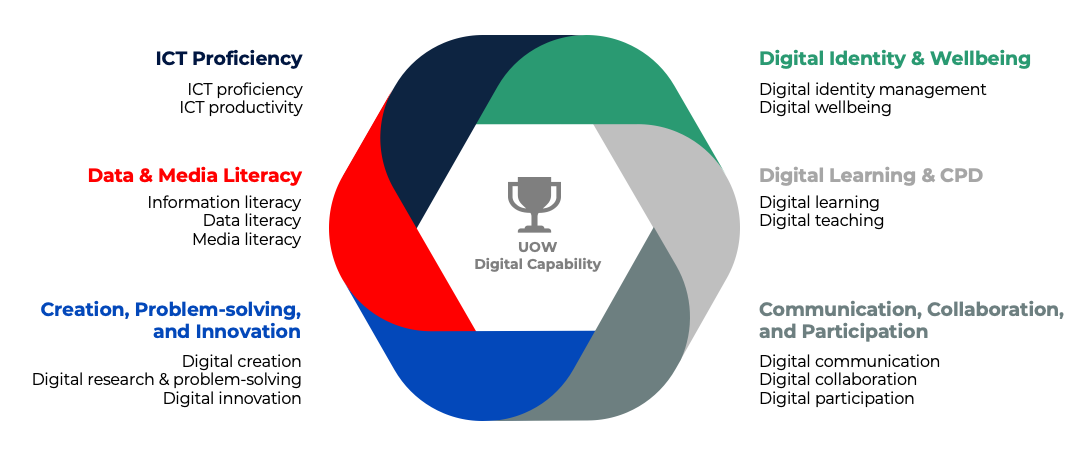Digital Capabilities @ UOW is a key component of UOW's Blended Learning Enhancement Initiative. Digital Capabilities are an important part of the fabric of UOW's digitalisation strategic initiatives for staff and students.
Get involved
To register your interest in joining the UOW Digital Capabilities Community, please contact ltc-central@uow.edu.au.
What are Digital Capabilities?
Technological change is nothing new (though the pace of change in the 20th and 21st centuries is faster than any other time in history). Technological change has impacted both the process and nature of knowledge practices such as teaching, learning, and work. As a result, there is a need to use shared definitions and frameworks to describe digital capability. The definition of digital capability created by JISC is shared by numerous institutions throughout Australia and globally.
Digital capabilities equip an individual to live, learn and work in a digital society (Jisc, 2014b). They encompass literacy, fluency, confidence and skills (Beetham, 2017), relating to attitudes as well as to actions. They focus more on acquiring transferable skills like behaviours and practices than the digital technologies themselves. Digital capabilities will vary according to discipline requirements, roles and responsibilities and will also reflect the culture and infrastructure of an institution (UTas, 2020).
Digital capabilities refer to a set of digital behaviours, practices, and identities. These digital behaviours, practices, and identities are socio-culturally defined, changing over time and across contexts. Our digital capabilities are a set of academic and professionally situated practices that align with our use of a range of diverse and changing technologies.
"The extent to which culture, policy, and infrastructure [within an institution] enable and support digital practices. At the individual level digital capabilities are the those that equip someone for living, learning, working, functioning in, and contributing to the digital society"
- JISC (2017)
Why are Digital Capabilities Important?
Digital capabilities allow individuals to adapt and thrive in a contemporary learning environment and to contribute to a global society. Our staff’s digital capabilities will underpin the innovative design of learning resources and pedagogical practices in course and curriculum design and delivery. They will also facilitate student development and inspire student engagement and understanding.
Conscious development of digital capabilities has individual and organisational benefits (Jisc, 2014b):
- providing quality education in flexible and innovative ways
- meeting expectations and needs of a diversity of students through an enhanced learning experience
- improving employability and higher skills in a digital economy
- attracting more students in a global education market
- improving processes, systems and building organisational capacity
- maximising the value of investments in learning technologies, content and services
The Digital Capabilities Framework

The JISC Digital Capabilities Framework (JISC, 2017)
The Six Elements
Download the JISC Digital Capabilities Framework (JISC, 2019).
ICT Proficiency (Functional Skills)
ICT proficiency relates to the use of information communication technologies (devices, applications, software, services, platforms, social media) in a higher education context. to carry out tasks efficiently, productively, and with an attention to detail that UOW is known for.
Information, data, & media literacies (Critical use)
Information literacy is the capacity to find, evaluate, manage, curate, organise and share digital information. Data literacy is the capacity to collate, manage, access and use digital data. Media literacy speaks to our ability to critically receive and respond to messages in a range of digital media.
Digital creation, problem solving, & innovation (Creative production)
Digital creation is our capacity to design and/or create new digital artefacts and materials. Digital research & problem-solving is characterized by our ability to use digital evidence to solve problems and answer questions. Digital innovation sees us adopting and developing new practices with digital technology.
Digital communication, collaboration, & participation (Participation)
Digital communication relates to our capacity to communicate effectively in digital media and spaces such as text-based forums, online video and audio, and social media. Digital collaboration is about how we participate in digital teams and working groups; to collaborate effectively using shared digital tools and media. Digital participation – our participation, facilitation, and building of digital networks.
Digital learning and continued professional development (Development)
Digital learning is the capacity to participate in and benefit from digital learning opportunities. Digital teaching – is our capacity to support and develop others in digitally rich settings, to teach, to work in a teaching or curriculum team, to design learning opportunities, to support and facilitate learning, to be pro-active in peer learning.
Digital identity & Wellbeing (Self-Actualisation)
Digital identity management speaks to our capacity to develop and project a positive digital identity or identities and to manage digital reputation (personal or organisational) across a range of platforms. Digital wellbeing is our capacity to look after personal health, safety, relationships and work-life balance in digital settings.



